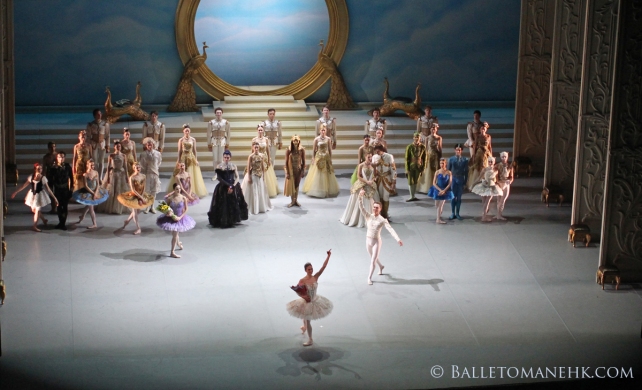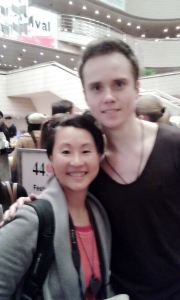
This year, the Hong Kong Arts Festival presented “The Sleeping Beauty” by Mikhailovsky Ballet of Russia. Like winning the lottery, I happened to have bought the tickets for the show with Polina Semionova and Leonid Sarafanov in the leading roles.
Prior to the performance, my biggest expectation was to see Polina and Leonid flaunting their extraordinary technique on stage, but the show turned out to give me so much more. I didn’t realize that the choreography is by Nacho Duato, a Spanish choreographer known for his European contemporary style. The changes from the “traditional version” with Petipa’s choreography and staged by the Mariinsky Theater, along with the brilliant costumes and sets designed by Agnelina Atlagic, kept me wide awake the whole evening.
One refreshing change in Duato’s choreography is the absence of mimes. “I try to show the characters and their replationships through dance,” he said in an interview published in the playbill, adding that the mime scenes were a device in the old days for the principal dancers to take some time to rest in between, but due to the improved techniques and stronger dancers today, such a device is unnecessary.
With this change, the music becomes more alive with continuous dance movements without much slowing down of the momentum. Even the King and the Queen were seen dancing (the Queen visibly more), making them characters that are more vibrant.
When it comes to the movement style, the non-classical use of the arms and the head and the sometimes exaggerated extension of the torso reminds me of William Forsythe–but dressed in Baroque costumes! To the traditionalists, this may look very jarring. But when this style was used by the fairies, it exudes a kind of oddity that is quite acceptable and amusing to me. After all, these are fairies with non-human qualities, and such movements add humor to the piece.
While many of Petipa’s classical steps have been altered, the overall feeling I got while watching the show was that the emphasis on the inner emotions of the characters trumps the flaunting of bravura techniques and high extensions. Many a high arabesque has given way to a more subdued line such as a lot of moderate back attitudes and low arabesques. There seems to be a more natural progression of the story line, with more subtle emotions conveyed as the number of exciting “tricks” was reduced.
Speaking of inner emotions, I really enjoyed the brilliant interpretations of Polina and Leonid in their respective roles. Polina was the perfectly convincing 16-year-old when she first appeared, innocent, wide-eyed, coquettish. When she was pricked by the huge needle given to her by Carabosse, you can literally see her energy diminish, as if her soul actually left her body on stage. I especially like the scene where she woke up after being kissed by the Prince and stumbled in a frail body before being able to walk again. The transition between a 100-year-old sleep wasn’t so abrupt as some of the other versions I have seen, where Aurora just perked up in a split of a second, ready to stand upright en pointe! (I later heard from my teacher, who was sitting very close to the stage, that Polina actually stumbled by mistake and made a thump, but it was a detail that I missed, being seated in the top circle).
Leonid also played his role as Prince Désiré extremely well, expressing a big contrast between how disinterested he felt about the women in the hunting scene and how he was enchanted by the Lilac Fairy and was later completely love-struck by the appearance of Aurora in a vision.
Without the miming, there was enough time for the characters to express their emotions more fully, and this was the biggest satisfaction that I got from Duato’s version.
Ekaterina Borchenko danced the Lilac Fairy and put up a strong performance. Her character played a heavier role than Petipa’s version, tying the various pieces of the plot with a red thread (or purple thread for that matter!). Some remarked though that the role should’ve been danced by a more experienced dancer who can hold down the ford.
The portraits of the fairies were a bit disappointing as the individual differences were not pronounced enough, neither through the choreography nor the music.
The Garland Waltz at the beginning of the ballet were danced by young adults instead of the usual children dancers in the original version, and the peach-green costumes really made the dancers look as if they were flowers swaying in the breeze.
I love the sets and the costumes. The contrasting lighting and colors of the sets between the scenes was a clever device to contrast the good with the evil, with black being the predominant color with every appearance of Carabosse, the evil fairy, whose costume and character play was outstanding.
As for the costumes, the ornamental Baroque style done in a restrained, minimalist way was a feast for the eyes. The colors were luxurious and harmonious. No wonder these costumes were worthy of a catwalk (see video below):
Now, let’s talk about the Rose Adagio, the highlight of every “Sleeping Beauty” production. I don’t recall seeing any actual roses received by Aurora during the scene. The four princes were given more frequent rounds to approach the Princess and so it appeared that each of them was given relatively less importance than in the traditional version. While Polina’s technique was impeccable, the focus of the dance, so tightly arranged, seemed to steer the audience in the direction of feeling the frustration of the Princess in having to choose among the four uninteresting princes rather than gasping at her technique alone. This subtle difference gives this adagio a refreshing feel.
The final wedding scene was wonderful and not too drawn out. I love the pussy cat scene a lot more than the Blue Bird, which did not show enough exuberance in my view. The solos and pas de deux by Polina and Leonid were the true highlights of the evening. Polina’s beauty and talent shined as brightly as her glittery tutu, while Leonid’s superior ballon and jumps were a show-stopper. There was a very sweet chemistry between the two.
All in all it was a very enjoyable performance, and it was a dream come true to see the two superstars of today’s ballet world up close!

Yours truly with Leonid Sarafanov at the Cultural Centre–Alas! The picture is so blurry due to my cheap smartphone, but still happy to have taken a snapshot with him. Wasn’t lucky enough to take a picture with Polina though.
